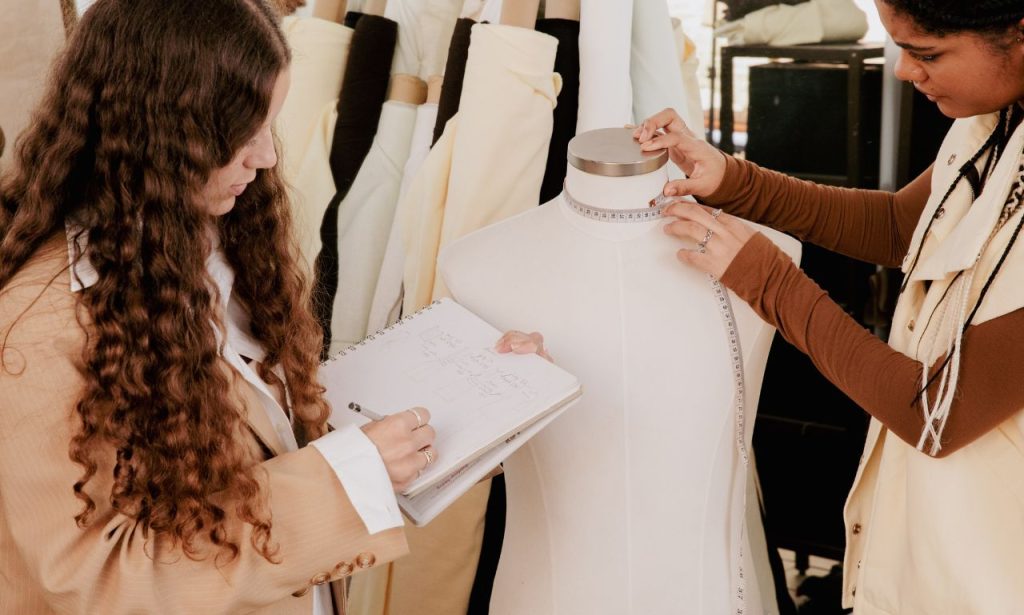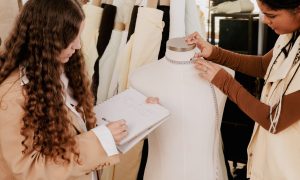Want to break into the fashion industry? I get it. The clothing business can be advantageous for creative entrepreneurs passionate about fashion. But here’s the truth—success requires more than just great designs. You need solid business fundamentals, industry knowledge, and strategic planning.
In this guide, I’m sharing the framework that has helped my clients launch profitable clothing lines. Whether you dream of creating high-end fashion or starting a print-on-demand t-shirt company, these steps will lead you to success in the competitive fashion industry.
Create a Clothing Business Plan
Your business plan should identify your target market. Who exactly are you designing for? What’s their age range, income level, and lifestyle? Understanding your target audience influences everything from your designs to your pricing strategy.
Financial projections are non-negotiable. Calculate your startup costs, including equipment, materials, manufacturing, and marketing expenses. Be realistic about your initial investment needs. Most clothing businesses require at least $5,000-$10,000 to get started properly, but the range can vary dramatically depending on your business model. Factor in operating costs for at least six months before you expect to turn a profit.
Don’t forget to research your competition thoroughly. What other clothing brands in your niche are doing well? Where are they falling short? Identifying these gaps creates your opportunity to stand out in the marketplace.
Develop Your Fashion Design Skills

If you’re not a designer, consider partnering with someone with these skills or outsourcing your designs. Many successful clothing business owners focus on business while collaborating with talented designers who share their vision.
Take time to develop your unique aesthetic. Your distinct style will become your brand’s signature in the crowded clothing market. Study fashion history and current trends, but don’t copy what’s already there. The most successful clothing lines offer something fresh while remaining wearable and marketable.
Learning technical skills like pattern-making and sewing can give you tremendous advantages, even if you outsource production. Understanding the construction process helps you communicate effectively with manufacturers and ensures quality control.
Set up Production and Manufacturing for Your Clothing Line
In-house production gives you complete control over quality and timelines, but requires significant equipment and skilled labor investment. This approach works best when creating limited quantities or highly specialized items.
Contract manufacturing allows you to scale more easily without massive capital investment. When selecting a manufacturer, don’t just go with the cheapest option. Request samples, check references, and ensure they can deliver consistent quality. Many of my clients start with local manufacturers despite higher costs, then transition to overseas production as they scale.
Print-on-demand (POD) has revolutionized the apparel business by eliminating inventory risk. With POD, items are produced only after being sold, dramatically reducing upfront costs. This model works exceptionally well for graphic tees and simple products, but offers less control over materials and construction details.
Whichever route you choose, establish clear quality standards and communication protocols with your production partners. Document everything in writing, from materials specifications to delivery timelines.
Source Fashion Fabrics or Design Your Own
Building relationships with reliable fabric suppliers takes time but pays dividends in consistency and potentially better pricing. Don’t be afraid to request samples before committing to large orders. Testing how fabrics wear, wash, and hold color will save you headaches.
For truly unique offerings, consider designing custom fabrics. Digital printing services make small-batch custom fabric production more accessible than ever before. This approach can set your brand apart, though it typically comes with higher costs and longer lead times.
Sustainability is increasingly important to consumers. Exploring eco-friendly fabric options can be a moral choice and a smart marketing angle. Organic cotton, recycled polyester, and innovative materials like Tencel are gaining traction in the fashion industry.
Design and Develop Your Clothing Line
Successful clothing lines strike a balance between creativity and commercial viability. Your designs should express your unique vision while appealing to your target audience.
Start with a cohesive collection rather than random pieces. I recommend beginning with 10-15 designs that work together and can be mixed and matched. This approach gives customers more ways to incorporate your pieces into their wardrobes.
Develop detailed tech packs for each garment. These documents include specifications like measurements, materials, colors, and construction notes. Thorough tech packs ensure your manufacturer produces exactly what you envisioned and serve as your quality control standards.
Prototype development is crucial. Never move to full production without testing and refining your designs through multiple samples. Yes, this takes time and money, but launching with flawed products will cost you far more in the long run.
Plan Your Collections Around Fashion Seasons
The traditional fashion calendar revolves around seasons: Spring/Summer and Fall/Winter. However, many successful modern brands have moved to more frequent “drops” or seasonless collections.
For beginners, start with two seasonal collections per year. This pace gives you adequate design, production, and marketing time without overwhelming your resources.
Planning your design and production timeline backward from your desired launch date is essential. Account for potential delays, especially when working with overseas manufacturers—factor in shipping times, quality control, and marketing preparation.
Keep your finger on the pulse of fashion trends, but don’t chase every fleeting fad. Instead, interpret trends through your brand’s unique lens, creating pieces that feel current but remain true to your aesthetic.
Source your Product
Developing relationships with multiple suppliers provides backup options when challenges arise. Supply chain disruptions happen, and having alternatives keeps your business running smoothly.
Bulk purchasing can significantly reduce per-unit costs, but balance this against storage limitations and cash flow considerations. Starting, you might pay more per unit for smaller orders, but this approach reduces risk until you’ve validated market demand.
Quality control is non-negotiable at this stage. Establish clear inspection protocols for incoming materials and finished products. Document your standards and train anyone involved in the quality control process to maintain consistency.
Establish Sales Channels
Your sales strategy will likely combine multiple channels, each serving different customer segments and business goals.
E-commerce is essential for modern clothing brands. Your website gives you complete control over the customer experience and higher profit margins. Platforms like Shopify make setting up a professional online store relatively simple, with payment processing, shipping, and inventory management integrations.
Wholesale relationships with boutiques and retailers can dramatically expand your reach and lend credibility to your brand. However, wholesale pricing typically means selling at 50% of retail, so factor this into your cost structure.
Marketplace platforms like Etsy or fashion-specific sites can put your products in front of established audiences. These platforms charge fees but can provide valuable exposure, especially when you’re just starting.
Pop-up shops and trunk shows offer opportunities to connect directly with customers and gather immediate feedback. These temporary retail experiences create urgency and excitement around your brand.
Hire and Train Your Retail Team
You’ll likely need to build a team as your clothing business grows. Start by identifying which functions are most critical to your success and which can be outsourced or delayed.
Retail staff represent your brand to the world. Hire people who understand and embody your brand values. Provide thorough training on procedures, your brand story, and what makes your clothing special.
Consider hiring freelancers for specialized functions like photography, graphic design, or social media management before making full-time hires. This approach gives you flexibility while you scale.
Create detailed documentation of all processes to maintain consistency as your team expands. From customer service protocols to inventory management, clear guidelines ensure your growing team upholds your standards.
Implement your Marketing Strategy

Effective marketing is as important as your actual product in the crowded clothing market. Your marketing strategy should focus on building brand awareness and direct sales.
Social media is compelling for fashion brands. Visual platforms like Instagram and TikTok showcase your designs in action. Consistency is key—develop a content calendar and maintain a regular posting schedule.
Influencer partnerships can dramatically expand your reach when done correctly. Look for micro-influencers (10,000-50,000 followers) whose audience matches your target market and aesthetic aligns with your brand.
Email marketing remains one of the most effective channels for converting and retaining customers. Build your list from day one and develop targeted campaigns for different segments of your audience.
Don’t underestimate the power of PR. Feature stories in fashion publications, both online and print, lend credibility to your brand. Share your unique brand story to develop relationships with fashion editors and bloggers.
Conclusion
Building a successful clothing business requires passion, patience, and perseverance. The fashion industry is competitive, but there’s always room for brands that offer something distinctive and connect authentically with their audience.
Remember that most clothing businesses don’t become overnight successes. Be prepared for a marathon, not a sprint. Stay flexible and responsive to market feedback while remaining true to your core vision.
I’ve seen countless fashion entrepreneurs succeed by combining creativity with solid business fundamentals. With thoughtful planning, quality execution, and strategic marketing, your clothing business can thrive in this dynamic industry.
ALSO READ: Trends Marketers Need to Watch for in 2025
FAQs
Startup costs typically range from $5,000 to $50,000, depending on your business model, production method, and scale. Print-on-demand requires the least upfront investment, while establishing your manufacturing operation requires the most.
No, but you need either design skills or a partnership with someone who has them. Many successful clothing business owners are self-taught or learned through mentorship and experience.
Research online directories, attend industry trade shows, ask for referrals from other non-competing brands, and consider local and overseas options based on your quality requirements, minimum order quantities, and budget.
Most new clothing brands start online to validate their concept before pursuing wholesale accounts. Your e-commerce store provides valuable direct customer feedback and higher profit margins.
Extremely important. Fashion is visual, so platforms like Instagram and TikTok are essential for building brand awareness. Consistent, high-quality content showcasing your products is a must for clothing businesses.




